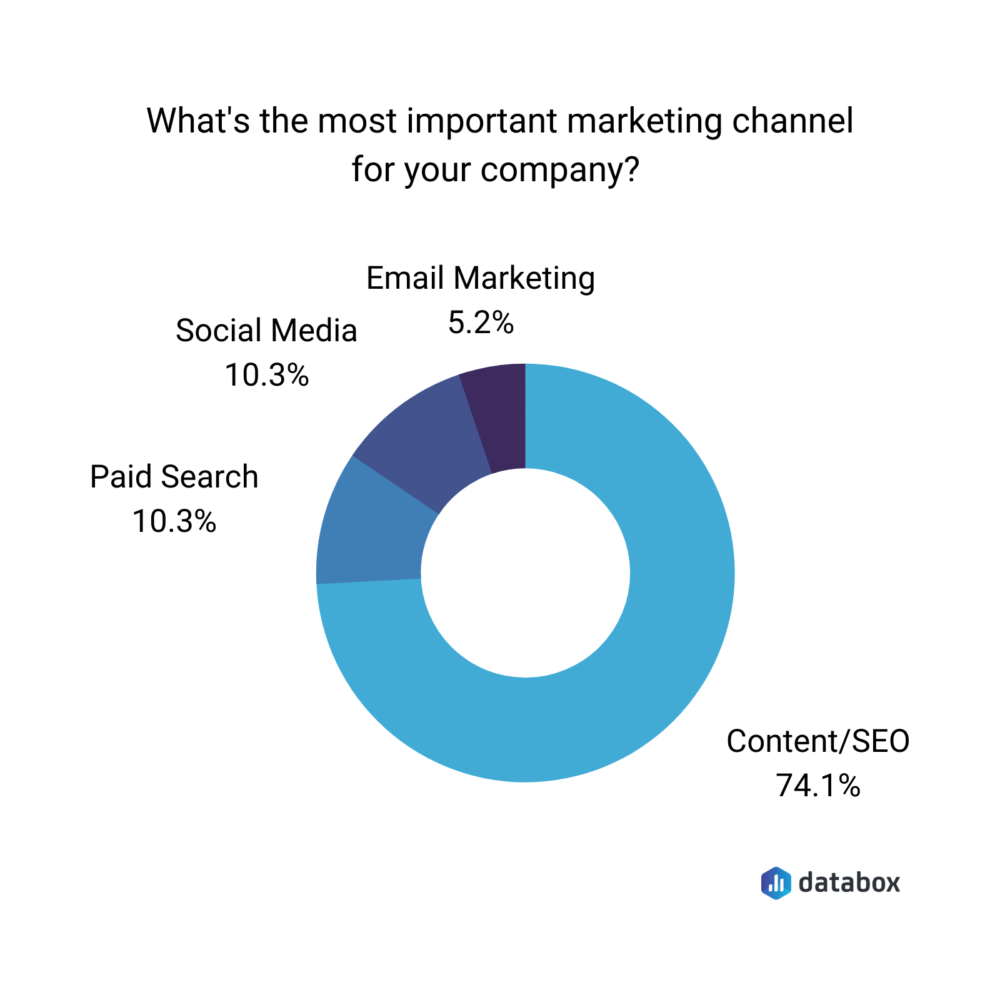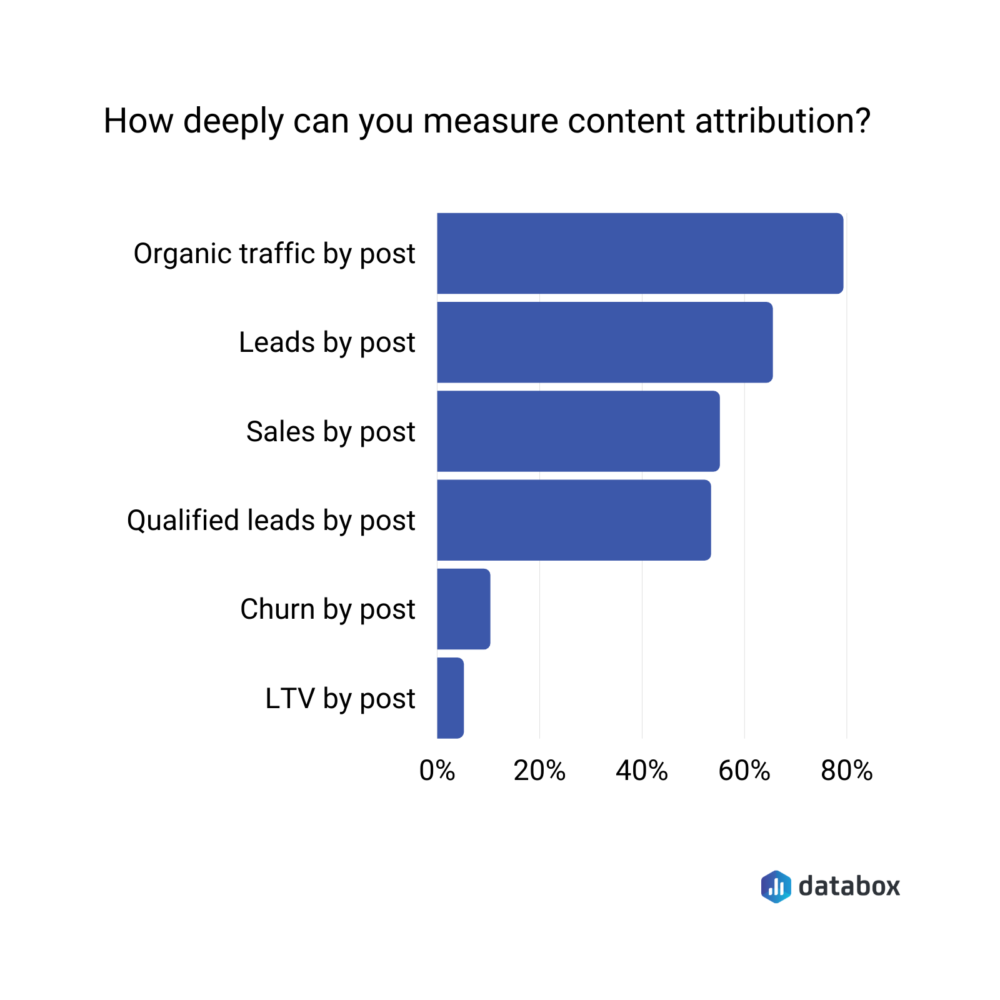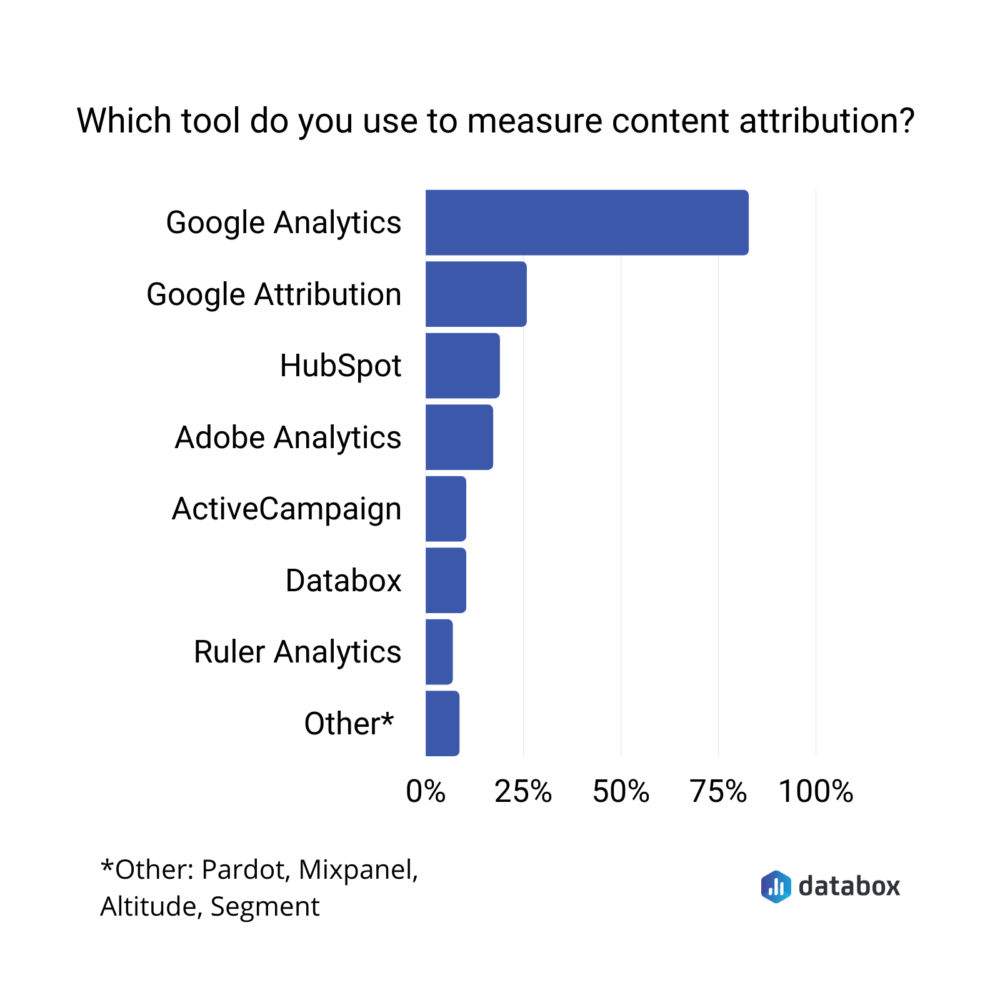Table of contents
So you’ve been pumping out content on a regular basis. Kudos to you! ?
But does that content really meet your audience’s expectations? Does that content actually encourage them to take action?
Not sure?
Enter: content attribution, the process that’ll help you understand how well your content converts. Put another way, it’s the measure of your content’s ROI.
Ready to get started with content attribution?
Let’s dig into the basics of content attribution and show you how to measure it.
- What is Content Attribution?
- What are the Best Content Attribution Tools?
- 10 Tips for Measuring Content Attribution
What is Content Attribution?
Attribution refers to actions users take to achieve a desired action step. This means content attribution is tracking which of your content encourages visitors to take the desired action.
Keep in mind that your goals from each content piece/campaign may vary, which means content attribution can range anywhere from measuring conversion from traffic to leads and leads to customers.
Content attribution also depends on the channel you’re using and how deep you want to go into measuring your content’s effectiveness in delivering results. Most of the respondents we polled for this survey use SEO content as their main marketing channel. This means they’re most likely looking to see how well the content they are creating for ranking in the search engine is attracting traffic.

Speaking of conversions, almost 80% of the experts measure how well a post converts in terms of getting organic traffic. About 63% also measure leads by post and some 58% look at the sales each post brings. 55% track qualified leads by post as well.

Related: 8 Ways to Get Started with Marketing Attribution
What are the Best Content Attribution Tools?
Of the 58 respondents who contributed to this piece, 82.76% of respondents state they are using Google Analytics to measure content attribution.
Other popular tools, not as popular as Google Analytics are: Google Attribution, HubSpot, Adobe Analytics, ActiveCampaign, and Databox.

Marina Vaamonda from PropertyCashin, a Databox user, recommends you take your time in selecting the tools you’ll need for measuring content attribution. “It would be best if you determined the correct attribution model for your marketing strategies to find appropriate tools,” Vaamonda advises.
Here’s more on how to pick the best tool for your needs. “There are many analytics tools available today, but not everything can cater to every marketer’s demands.” So take the following steps:
- “Study the data analytics offer of each tool in the market [and]
- Make sure to identify which tools have the features that you need.
Most of the time, you’ll use at least two tools since it is difficult to find everything in a single software alone.”
In light of this, Insynth Marketing’s Dorian Wallace shares HubSpot CMS. Sharing their experience, Wallace writes, “We use the HubSpot CMS to track the performance of our content. HubSpot allows us to gain deep insights into how our content is converting, see the contacts generated and the customers produced.”
By attributing content adequately, Wallace and the team has learned that “making individual campaigns for each lead magnet allows greater control over attribution as we can see exactly which campaign a customer or contact has come from and identify which content piece has converted them. This includes websites, blog, email marketing, and social media.”
Having this information has let them “optimize the higher converting content and improve lower converting ones. HubSpot does this automatically making tracking our content attribution super-efficient.”
10 Tips for Measuring Content Attribution
Now, for the meaty details:
- Give your campaigns a unique URL parameter
- Ask customers directly
- Set up a custom model comparison tool
- Leverage Google Analytics
- Use UTM tagging
- Study your content engagement metrics
- Employ single-touch attribution
- Use multi-touch attribution
- Look at the revenue goal path
- Keep tabs on your backlinks
PRO TIP: Measure Your Content Marketing Performance Like a Pro
Struggling to track the impact of your content across platforms? We feel you. Thanks to Databox, fragmented data doesn’t have to hold you back anymore.
Our library of free content marketing dashboard templates puts all the insights and metrics you need in one place. No more jumping between reports!
Measure engagement: Track key metrics like likes, comments, shares across social media platforms to see what content resonates most with your audience. Analyze website traffic, bounce rate, and average time on page to understand how visitors interact with your content.
Optimize conversions: Identify high-performing landing pages and blog posts that drive the most leads using dashboards like HubSpot Marketing Lead Source. Analyze campaign performance and user activity for both organic and paid content with a Facebook Pages & Facebook Ads dashboard.
Improve SEO: See which pages rank highest in search results and drive the most organic traffic. Improve search visibility by visualizing key SEO factors like backlinks and domain rank.
You can easily set it up in just a few clicks – no coding required.
To set up a dashboard, follow these 3 simple steps:
Step 1: Choose a fitting template
Step 2: Connect your data
Step 3: Watch your dashboard populate in seconds
1. Give your campaigns a unique URL parameter
“One simple tip for measuring content attribution is to give all your online campaigns a unique URL parameter,” advises Mallory Davis of Volvo Cars Cool Springs.
The reason? “So you can track them easily in your analytics tool, or, create a separate landing page for each campaign contact form so you can track leads and traffic by campaign that way.”
“Either way you want to be sure you have a clear, easy way to determine exactly where your traffic leads are coming from, whether that is by creating campaign specific URL parameters or unique campaign landing pages,” Davis adds.
2. Ask customers directly
There’s no better way to learn where customers learned about you than by asking them. To this end, use a contact form to ask them about what made them decide– a suggestion by Jerome Williams from JWorks Studios.
“This can be a simple text box or let them choose from the drop-down selection box. So, if you want to track content attribution, list the different points of entry such as a newsletter, specific blog post, a tweet, etc.,” Williams writes. “This is a similar method of gathering marketing information such as the ‘How did you hear about us’ section of a contact form.”
You can also set up “a survey question before the consumer completes a purchase asking them where they heard about your service,” adds Tomasz Mlodzki of photoAiD. “This way, they don’t just skip the survey and you get the data you need.”
Better yet? You can get more customers to fill up the survey if you incentivize them, for example, by offering a discount code on the next purchase. This way, you’ll get your answer as well as increase the odds of repeat business.
3. Set up a custom model comparison tool
Another tip for effective content attribution is to “set up a Custom Model Comparison Tool to measure Blog ROI” shares Inter’s Lauren White.
“It is a great way to see if a customer’s first interaction with the site was a blog post (identifying a specific URL). Then we can take it further by tracking if that customer made a purchase within 30 days of their first interaction with the blog post,” says White.
4. Leverage Google Analytics
“If you’re dealing with multiple campaigns, multiple publishers or even multiple pieces of content, then Google Analytics can help you calculate the attribution,” Abby Ha of WellPCB suggests. “This is because GA (and other big data tools) can pool your data and provide you with the insight you need.”
TRGDatacenters’ Eric McGee explains the route to take: “You can access the data through this path: Go to ‘Conversions,’ which is located in the left menu > Click on ‘Assignment’ > Just click on ‘model comparison tools.’”
McGee shares a word of advice too. “A marketer needs to keep in mind that consumers are affected daily by campaigns on multiple channels. Therefore, you must put a value on each one.”
Doing so will help you boost “the results of your strategies, identify those channels that need improvement, and bring a complete view of your team’s whole effort” simply by using attribution models to study what’s working.
Also, don’t forget to setup basic conversion tracking in Google Analytics. Forgetting to do so is, in fact, “the biggest mistake” that Nate Rodriguez from LIFOFF Digital sees marketers making.
So “setup your basic conversion tracking for your goals like email opt-ins, trial signups, etc. Then you can go the extra mile and setup the multi-channel model comparison report in Google Analytics. This will get you the most accurate data as to how your content is performing and how it contributes to your overall conversion goals.”
5. Use UTM tagging
Another way to learn how well your content is driving traffic to take action is to use UTM codes and tagging. In fact, Triodox’s Ruslan Konygin goes on to say that leveraging UTM-tagging for external website links is “the simplest tip for measuring content attribution.”
Here’s how the process unrolls: “Let’s say you created an article on the website blog and planning to share it on Facebook. Just add UTM-parameters to your link:
utm_source=”facebook.com”, utm_medium=”social” and some unique utm_campaign(like “post-43-how-to-measure-content-attribution”).
Using the unique utm_campaign value allows analysis in Google Analytics report which certain shared post assisted sales and leads.”
Yoann Bierling from International Consulting adds to this: “UTM codes are kings in clicks tracking,” quips Bierling. “The most granular you can go, the better it is. Each link should be uniquely identified with a specific UTM code, that ideally should contain several parameters to ease search and comparison, such as page ID, paragraph number and exact link ID.”
That said, Konygin warns about using UTM tagging for external links only – not internal links.
6. Study your content engagement metrics
Do you get a lot of organic comments on your blog pieces? Are visitors clicking through the links you’ve shared? Congratulations! You’ve decent engagement on your content, indicating what you’ve created is resonating with your audience.
To add, “content engagement metrics can help you figure out whether your website’s visitors are interacting with the content in the way you anticipated. Bear in mind that your blog traffic is accumulated if you publish a blog post. It’s perfect if just a few people visit the post on the first day. Measure it using a content marketing dashboard over the course of a month, three months, and so on,” advises Brian Stewart from ProsperoWeb, LLC.
7. Employ single-touch attribution
Next, track content performance by watching only one marketing touchpoint or single-touch attribution.
“There are several ways you can measure content attribution, but the best one to start off with is single-touch attribution,” opines Lauren Amor from Tandem Interactive.
Amor finds this attribution model helpful for new companies, businesses, and “those who are looking for a quick and easy way to improve their marketing practices.”
Essentially, both first-touch and last-touch click are equally worth measuring. “First touch attribution – in which credit completely goes to the campaign that initiated the visitor’s initial interaction with the site – is a great way to learn what content is performing best on your site,” Amor explains.
On the other hand, “Last touch attribution – which gives complete credit to site visitors’ last interaction with your site before they’ve converted to a paying customer – offers more insight on what content was strong enough to hook visitors and turn them into customers,” Amor outlines.
Hence, first-touch attribution tells you which content get you the most leads and second-touch attribution identifies content that converts leads into customers.
- Use first-touch attribution
In this regard, Aaron Haynes from Loganix recommends that a simple way to measure content attribution is by measuring first-click attribution.
“You want to measure the efficiency of your content at driving visitors to your website even though they might decide to take action a few days later,” Haynes points out. “For example, Google Analytics lets you track both first & last interaction which can be a good indicator of how your content attributes to sales.”
Tony Mariotti of RubyHome backs this tactic for measuring your content’s effectiveness. “One simple tip is to focus on ‘first touch’ attribution, particularly for new sites looking to attract that first line of interest to their site.
Explaining further, Mariotti shares, “First Touch: Think about content creation as the first touch. It’s your way to attract leads. This can be blog posts or other creative content creation leading customers to your site (YouTube videos, social posts, etc). Often this is a very wide range of topics that intersect with what your brand is providing to the customer.”
“Analyzing which pages are doing well provides valuable insight into what kind of content your customers are interested in and can help you further develop topics related to well-performing, first-touch pages,” Mariotti continues.
- Use last-click attribution
Blissfully’s Alex Birkett, however, weighs in favor of last-click attribution. “Attribution is mostly a fool’s errand. In the case that you have a great analyst and customer journey map (as well as investments in multiple channels), attribution is important,” Birkett writes.
“For most companies, it’s wasted effort and you should opt for a simple attribution model that tells you what you need to know, even if it misses out on some details.”
It’s for this reason Birkett prefers and suggest a “last click attribution model for content.”
Here’s what to do: “Simply set up a goal page (e.g. “site.com/thank-you”), set up a goal in Google Analytics to represent that page, and pull a report from the Behavior > Landing Pages report that calculates the # of last click conversions to those pages.”
8. Use multi-touch attribution
Besides, single-touch attribution, our experts vouch for multi-touch attribution too.
“The way we go about measuring content attribution is using a multi-touch method such as Position-Based Attribution to assign as much value as we can to the first and last contact point,” Mladen Maksic from Play Media elaborates. “Then we use a custom in-house method to ensure correct attribution of all the steps in between.”
Courseforme.com’s Daren Nadav speaks in favor of linear attribution. “Linear attribution is the approach where every touchpoint involved gets credit for attribution. It gives equal value to all the touchpoints that complete an attribution. While this may not be very accurate as every touchpoint does not have an equal contribution. This approach is helpful as it tells you about every touchpoint involved and essential for your attributions.”
9. Look at the revenue goal path
Sasha Matviienko from growth360 suggests you study your customer’s journey to learn which content they consume as they make their purchasing decisions.
To this end, Matviienko says, “I recommend businesses start with basics, try looking at the Reverse Goal path to determine how consumers move to purchase, content-wise.”
Next, “compare this insight to how long it takes for your customers from discovering your brand to making a purchase. If you merge the two insights, you may see how you can potentially remarket (content visitors) with the content piece that is frequently viewed next on the path to purchase. This will allow you to shorten the sales cycle and increase the number of leads with a small investment.”
Music Grotto’s Jenna Carson agrees with this approach. “Different customers or buyers will need different types of content before they complete the desired action you want them to do! If you don’t take into consideration the buyers’ journey, then you will not be measuring the content attribution in the right way.
“For example, is this the first time that person or business has viewed any of your relevant content and have they ended up on the least appropriate blog for this state of the journey? If that’s the case, they need to be measured in an appropriate way to get the right stats.”
10. Keep tabs on your backlinks
“One direct measurement for how successful your content marketing effort is should be the number of backlinks attracted, especially quality links you have gained,” points out Miranda Yan, VinPit.
Yan elaborates, “content attribution can be in the forms of videographics, infographics or skyscraper link-building. The number of backlinks you gain clearly shows if your content piece is being regarded by other sites as valuable or not, or if you are reaching out to the right websites with an audience that might be interested in your content.”
Put simply, focus on creating quality content because that’s content that resonates with your audience (hence, converts them) and attracts backlinks too – proving your content’s effectiveness.
In fact, “If your content piece is valuable enough, chances are it can even be quoted by authority sites such as TechAdvisor, with a huge customer base that might develop awareness into your brand,” Yan notes.
From tracking multi-touch attribution to setting models in Google analytics and surveying your customers, there are multiple ways to measure content attribution. Start with being clear about your goals and what you want to track. Then, select the right tool and marketing dashboard software and get to work.
















